| Oracle® Application Server Adapter for Siebel User's Guide 10g Release 2 (10.1.2) B14062-03 |
|
 Previous |
 Next |
| Oracle® Application Server Adapter for Siebel User's Guide 10g Release 2 (10.1.2) B14062-03 |
|
 Previous |
 Next |
This chapter describes how to configure OracleAS Adapter for Siebel and create schemas for Siebel Business Objects.
This chapter discusses the following topics:
Encoding Support on UNIX Platforms
When using OracleAS Adapter for Siebel on UNIX environments, you must manually edit the startup script for your server to add a JVM option specifying the file encoding:
java $REMDBG -cp $CLASSPATH -DIWAY55=$IWAY55 -Dfile.encoding=ISO8859_1 edaqm -config $SCRIPT $2 $3 $4 $5 $6
Prerequisites
Before starting OracleAS Adapter Application Explorer (Application Explorer) and using Oracle Application Server Adapter for Siebel (OracleAS Adapter for Siebel), you must create \endorsed directories under your OracleAS_home directory and place a copy of the xalan.jar file in those directories. Otherwise, you will receive a transformation error when adding an IO node under an Integration Object in Application Explorer.
Navigate to the OracleAS_home\j2ee\home\connectors\jca-app-adapter\jca-app-adapter directory and copy the xalan.jar file.
Search on your machine for the following directories, then create an \endorsed subdirectory under each of these directories:
OracleAS_home\jdk\jre\lib\
OracleAS_home\jdk\lib\
OracleAS_home\jdk\....\lib\
OracleAS_home\jre\....\lib\
Any \jdk\....\lib or \jre\....\lib that is in your PATH environment variable
Paste the xalan.jar file you copied in step 1 into each of the new \endorsed subdirectories.
Important: Please note that you may not have all the directories listed above. This depends on your individual environment.
Launching Application Explorer
To start Application Explorer:
Start the server where Application Explorer is deployed.
From the Windows Start menu, select Programs, OracleAS_home Adapters, and then Application Explorer.
On Windows, iaexplorer.bat is located under OracleAS_home\adapters\application\tools, where OracleAS_home is the directory where Oracle Application Server is installed.
On UNIX, load the script iwae.sh, located under OracleAS_home/adapters/application/tools, where OracleAS_home is the directory where Oracle Application Server is installed.
Application Explorer starts. You can now define new targets to your Siebel system.
Before a configuration can be created, you must configure OracleAS Adapter Business Services Engine (BSE). You need not configure OracleAS Adapter J2CA because the ra.xml file is configured automatically during installation.
After BSE is deployed to Oracle Application Server, you can configure it through the BSE configuration page.
To configure BSE:
Display the following page in your browser:
http://hostname:port/bse
Where hostname is the host name of Oracle Application Server and port is the HTTP port for Oracle Application Server.
For example,
http://localhost:7777/bse
|
Note: This page might load slowly when accessed for the first time. |
Log on when prompted.
When first installed, the user ID and the password are:
User name: admin
Password: admin
The BSE configuration page is displayed.
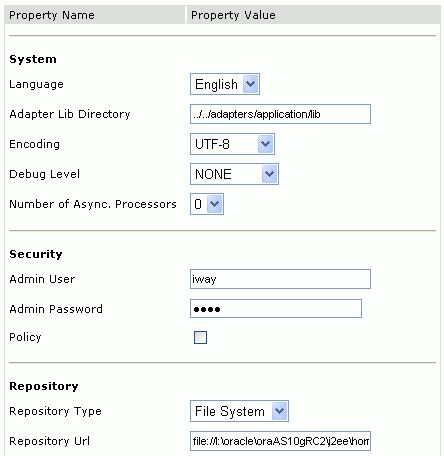
Ensure that the Adapter Lib Directory parameter specifies the path to the lib directory, for example:
OracleAS_home\adapters\application\lib
After you specify the path, adapters in the lib directory are available to BSE.
For security purposes, enter a new password in the Admin Password field.
|
Note: The Repository URL field specifies where the file system repository is located. To use a database repository, you must enter the repository connection information. For the initial verification, use a file system repository. See "Configuring an Oracle Repository" for information on switching to a database repository. |
Click Save.
To configure BSE system settings:
Display the BSE configuration page by using the following URL:
http://hostname:port/ibse/IBSEConfig
Where hostname is the machine where BSE is installed and port is the port number on which BSE is listening.
Important: The server to which BSE is deployed must be running.
The BSE settings window is displayed.
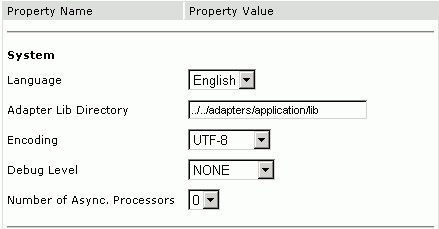
Configure the system settings by providing information for the parameters according to the following table.
The following image illustrates the Security pane of the window.

Configure the security settings by providing information for the parameters according to the following table.
| Parameter | Description |
|---|---|
| Admin User | Provide an BSE administrator ID. |
| Admin Password | Enter the password associated with the BSE administrator ID. |
| Policy | Select the check box to enable policy security. |
The following image shows all of the fields and the check boxes for the Repository pane.
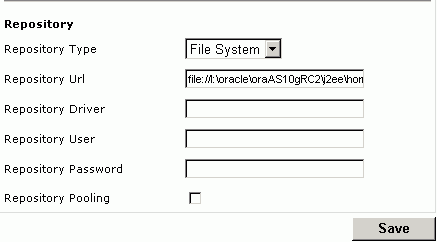
Configure the repository settings by providing information for the parameters according to the following table.
BSE requires a repository to store transactions and metadata required for the delivery of Web services.
See "Configuring a File System Repository" and "Configuring an Oracle Repository" for more information.
Configuring a File System Repository
If you do not have access to a database for the repository, you can store repository information in an XML file on your local machine. However, a file system repository is less secure and efficient than a database repository. When BSE is first installed, it is automatically configured to use a file system repository.
|
Note: Do not use a file repository for BSE in production environments. |
The default location for the repository on Windows is:
OracleAS_home\j2ee\OC4J_CONTAINER\applications\ws-app-adapter \ibse\ibserepo.xml
On other platforms, use the corresponding location.
If you are using a file system repository, you are not required to configure any additional BSE components.
Configuring an Oracle Repository
To configure an Oracle repository:
Contact your database administrator to obtain an Oracle user ID and password to create the BSE repository.
This user ID should have rights to create and modify tables as well as the ability to create and run stored procedures.
Open a command prompt and navigate to the setup directory. Its default location on Windows is:
OracleAS_home\adapters\application\etc\setup
For other platforms, see the corresponding location.
This directory contains SQL to create the repository tables in the following file:
iwse.ora
|
Note: If Oracle is not on the same machine as Oracle Application Server, copy the iwse.ora file to the Oracle machine. Then, from a command prompt on the Oracle machine, navigate to the directory containing the iwse.ora file. |
sqlplus userid/password @database @ iwse.ora
During the J2CA deployment of OracleAS Adapter for Siebel, OC4J generates a deployment descriptor called oc4j-ra.xml. This descriptor provides OC4J-specific deployment information for resource adapters. See Chapter 3, "OC4J Deployment and Integration" for more information on J2CA deployment and configuration.
No configuration changes are necessary if you are using the default file based repository with J2CA deployment.
Configuring a Database Repository for J2CA
To configure a database repository for J2CA:
Execute the iwse.ora SQL statement on the machine where the database is installed.
Copy the jcatransport.properties file to the following directory:
OracleAS_home\adapters\application\config\jca_sample
Uncomment the following fields and enter details for them in the jcatransport.properties file. For example:
iwafjca.repo.url=jdbc:oracle:thin:@90.0.0.51:1521:orcl iwafjca.repo.user=scott iwafjca.repo.password=scott1
Alter the JDBC driver path in Application Explorer's lcp. For example:
lcp=..\lib\orabpel-adapters.jar;C:\jdev\jdbc\lib\classes12.jar;C:\jdev\jdbc\lib\nls_charset12.jar;%lcp% to lcp=..\lib\orabpel-adapters.jar;..\..\..\jdbc\lib\classes12.jar;..\..\..\jdbc\lib\nls_charset12.jar;%lcp%
Before you use Application Explorer with OracleAS Adapter for Siebel, you must create a repository configuration. You can create two kinds of repository configurations, Web services and J2CA, depending on the container to which the adapter is deployed. During design time, the repository is used to store metadata created when using Application Explorer to configure adapter connections, browse EIS objects, configure services, and configure listeners to listen for EIS events. The information in the repository is also referenced at runtime.
A default J2CA repository is created for the default ManagedConnectionFactory. The name of this configuration is jca_sample.
Web services and BSE refer to the same type of deployment. See "Adapter Features" for more information.
To create a configuration for BSE using Application Explorer, you must first define a new configuration.
Defining a New Configuration for BSE
To create a new configuration for BSE:
Right-click Configurations and select New.
Enter a name for the new configuration (for example, SampleConfig) and click OK.
The following dialog box is displayed.
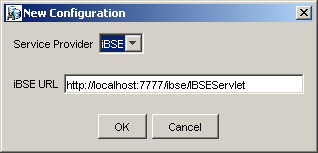
In the iBSE URL field, accept the default URL or replace it with a different URL using the following format:
http://hostname:port/ibse/IBSEServlet
Where hostname is the machine where your application server resides and port is the port number on which the application server is listening.
Click OK.
A node representing the new configuration appears beneath the root Configurations node.

The BSE configuration file is stored in OracleAS_home\j2ee\home\applications\ws-app-adapter\ibse.
To create a configuration for OracleAS Adapter J2CA using Application Explorer, you must first define a new configuration.
Defining a New Configuration for J2CA
To define a new configuration for J2CA:
Right-click Configurations and select New.
The New Configuration dialog box is displayed.

Enter a name for the new configuration (for example, SampleConfig) and click OK.
The New Configuration dialog box is displayed.
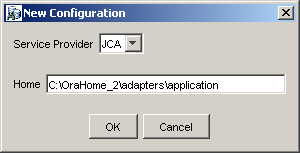
In the Home field, enter a path to your J2CA configuration directory where the repository, schemas, and other information are stored, for example:
OracleAS_home\adapters\application
Click OK.
A node representing the new configuration appears beneath the root Configurations node.

The OracleAS Adapter J2CA configuration file is stored in OracleAS_home\adapters\application\config\configuration_name
Where configuration_name is the name of the configuration you created; for example, SampleConfig.
To connect to a new configuration:
Right-click the configuration to which you want to connect, for example, SampleConfig.
Select Connect.
Nodes appear for Adapters, Events, and Business Services (also known as Web services). The Business Services node is only available for BSE configurations. If you are connected to a J2CA configuration, you will not see the Business Services node. The following is an example of a BSE configuration named SampleConfig:

Use the Adapters folder to create inbound interaction with Siebel. For example, you use the Siebel node in the Adapters folder to configure a service that updates Siebel.
Use the Events folder to configure listeners that listen for events in Siebel.
Use the Business Services folder (available for BSE configurations only) to test Web services created in the Adapters folder. You can also control security settings for the Web services by using the security features of the Business Services folder.
You are now ready to define new targets to Siebel.
To browse the Siebel Business Services, Business Components, and Integration Objects, you must define a target to Siebel. After you define the target, the parameters are automatically saved. However, you must provide the password to Siebel every time you connect to the target.
|
Note: The connection parameters required for defining a Siebel target can be obtained from the eapps.cfg file, which is located in the following directory:
drive:\SiebelRoot\SWEApp\BIN
Where |
In the left pane, expand the Adapters node.
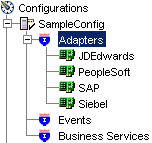
Right-click the Siebel node and select Add Target.
The Add Target dialog box is displayed. Provide the following information:
Click OK.
When you select Siebel 6.2 or lower (COM):
In the User Agent File field, enter the name of the configuration file.
In the Password field, enter the password associated with the user name.
In the Repository field, enter the Siebel Repository where Application Explorer looks for metadata describing Business Services, Business Objects, and Integration Objects.
If no repository is specified, a full list of objects from all available repositories will be returned. If a specified repository is not found, an empty list of objects will be returned.
When you select 6.3 or higher (JDB):
In the Gateway Server field, enter the name of the server. To specify a Gateway Server that uses a port other than the default (usually, 2320), add a colon and the port number, for example, gateway name:port number.
In the Enterprise Name field, enter the appropriate name.
In the Siebel Server field, enter the name of your Siebel server. Do not supply a value in this field when connecting to a Siebel 7.7 or 7.8 system.
In the User field, enter the user name.
In the Password field, enter the password associated with the user name.
Click the Advanced tab and verify the following:
Language
Object Manager
For Siebel 7.0.3, the default Object Manager is EAIObjMgr. For Siebel 7.7, the default is EAIObjMgr_enu. Siebel 7.7 requires that you add a language extension (for example, _enu) to the end of the Object Manager name. Check with your Siebel Administrator for the specific names that apply to your system.
If no repository is specified, a full list of objects from all available repositories is returned. If a specified repository is not found, an empty list of objects is returned.
The configuration parameters supplied are used by Siebel client applications to connect to the Siebel system. For more information about these parameters, see your Siebel documentation or ask your Siebel system administrator.
Repository Manager
If no repository is specified, a full list of objects from all available repositories will be returned. If a specified repository is not found, an empty list of objects will be returned.
The configuration parameters supplied are those used by Siebel client applications to connect to the Siebel system. For more information about these parameters, see your Siebel documentation or ask your Siebel system administrator.
|
Note: These parameters are typically found in Siebel configuration files stored under the Siebel serverroot/bin/<language> directory, where language is the Siebel code for the language you installed (enu for U.S English). For example, for Siebel versions 7 and higher on a Windows platform, for the Siebel Call Center module, these values can be found in the uagent.cfg file. Consult your Siebel administrator and your Siebel bookshelf documentation for more information. |
Click OK.
In the left pane, the target you create appears under the Siebel node.
To connect to a defined target:
Expand the Siebel node and click the target name to which you want to connect.

In the right pane, enter the password for that target.
In the left pane, right-click the target name and select Connect.
The target icon changes, indicating that you are connected to the Siebel system.

You can now browse the available Business Objects, Business Services, and Integration Objects in the Siebel system.
Although you can maintain multiple open connections to different application systems, it is good practice to close connections when not in use.
In the left pane, select the target to which you are connected.
Right-click the target and select Disconnect.
Disconnecting from the application system drops the target, but the node remains. The SiebelConnection node in the left pane changes to reflect that the target is disconnected.

In the left pane, ensure the target you wish to edit is disconnected.
Right-click the disconnected target and select Edit.

The Edit pane is displayed on the right.
Modify the target information.
Click OK.
You can delete a target, rather than just disconnecting and closing it. When you delete the target, the node disappears from the list of Siebel targets in the left pane of Application Explorer.
To delete a target:
In the left pane, select the target.
Right-click the target and select Delete.
A confirmation dialog box is displayed.
Click OK to delete the target you selected.
The Siebel connection node disappears from the left pane.
Application Explorer gives you the flexibility to view all Siebel application system objects. One benefit of this flexibility is that you can gain an understanding of the Siebel data structure. You can review parameters, data types, and other attributes of the Siebel data in the right pane.
To view metadata:
If you have not started Application Explorer, start Application Explorer and connect to your Siebel system.
In the left pane, expand the Business Object or Business Service containing the component for which you want to generate schema.
Expand the Business Object or Business Service node.
Expand the Business Component or the Business Service node to view the objects under it.
For a Business Component, select the node in which you are interested, for example, Account.

For a Siebel Business Service ,select the object in which you are interested, for example, addAccount.

In the right pane, click the ellipsis (...) in the Table row of the properties table.
The metadata table appears in the right pane.

You can create service schemas for Business Services and Business Components using Application Explorer.
The following topic describes how to create schemas for the adapter when you deploy OracleAS Adapter for Siebel for use either in a J2CA environment or a Web services environment. See "Creating and Testing a Web Service (BSE Configurations Only)" if you plan to deploy OracleAS Adapter for Siebel in a Web services environment.
Creating an XML Schema for a Siebel Business Object or Business Service
You create schemas for Siebel Business Service methods (for example, the Add method) and Business Components using Application Explorer. After you create a schema, you can use it to generate service request and response schemas for the Business Service or Business Component.
Siebel Business Objects contain one or more Siebel Business Components. You can view Business Components by clicking the associated Business Object.
The following image shows the Account Business Object expanded to display all Business Components.

Creating an XML Schema for a Siebel Business Component or Business Service
To generate service request and response schemas for a Business Component or Business Service:
If you have not started the Application, start Application Explorer and connect to your Siebel system.
In the left pane, expand the Business Object or the Business Service node.
Expand the Business Component or Business Service to view the objects under it.
For a Business Component, expand the Business Object node, then expand the Business Component you want, then expand the node you want, and select the method for which you want to create a schema.

For a Siebel Business Service, expand the Business Service node containing the object for which you want to create schema.

Right-click the node and select Generate Schema.
Application Explorer accesses the Siebel repository and builds schemas.
Schema tabs similar to the following appear in the right pane.

To view a schema, click the ellipsis tab corresponding to the schema you want to view.
The schema appears on the right.
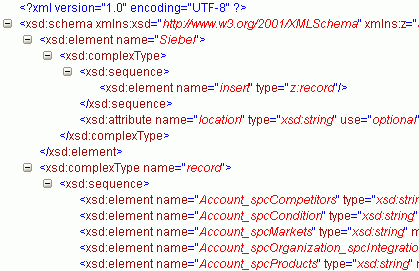
Searching for a Specific Siebel Object
You can use the search function in Application Explorer to locate a Siebel object or node quickly.
If you have not started the explorer, start Application Explorer and connect to your Siebel system through a target.
Expand the target and select Business Object, Business Service, or Integtration Object.
In the right pane, move the cursor over Operations and select Search.
Enter the name of the node or object on which you want to search in the text entry box, for example, Account.
Click OK.
A list containing the Siebel items that match your search appears.
Select the item in which you are interested.
Application Explorer locates the item in which you are interested.
Returning Fields in a Specified Order
When you create a request document from an XML schema to query the Siebel system, you can limit the expected response to specific fields that are specified in the query. The response will contain the fields in the order in which they were specified. If you do not specify a set of fields, the response document contains the entire set.
For example, the following query will return all fields:
<m:Siebel location="S/BO/Account/Account/queryWithView" view="AllView"> <m:select> <m:Name>Yelena*</m:Name> </m:select> </m:Siebel>
The following query will return a response that only contains the fields Name, Location and Account Status fields:
<m:Siebel location="S/BO/Account/Account/queryWithView" view="AllView">
<m:select>
<m:Name>Yelena*</m:Name>
</m:select>
<m:field>Name</m:field>
<m:field>Location</m:field>
<m:field>Account Status</m:field>
</m:Siebel>
Using QueryWithView
For Business Components, the iWay Application Adapter for Siebel enables Insert, Update, Delete, and Query. It also enables a method called QueryWithView. The View modes are a visibility feature provided by Siebel.
By using QueryWithView, you can specify a Siebel View mode as a parameter. The API parameters allow different presentations of data depending on the Siebel environment that you configured.
You can use Query except when you want to enable a user to retrieve records based on different view modes. In this case, use QueryWithView. For more information on QueryWithView mode or Siebel "Visibility" concepts, see your Siebel Administrator.
The following levels are available:
Sales Rep View
Manager View
Personal View
All View
Organization View
Group View
Catalog View
SubOrganization View
To create XML schemas for Siebel Integration Objects, you may have to generate XDR schemas first, using the Siebel Tools Schema Wizard.
The XDR schema is used as input to Application Explorer when generating schemas for integration objects. After you generate the XDR schema, Application Explorer uses the XDR file to generate the XML schema.
Please note:
For Siebel 7.5 and later: Generate XSD schemas directly from Siebel tools. These XSD schemas are used to create Web services directly using Application Explorer. After you generate an XSD schema through Siebel tools, use it to create an IO node and Web service.
For Siebel 7.0: You cannot generate XSD schemas directly from Siebel tools; only XDR schemas can be created. Therefore, to create a Web service, Application Explorer must first generate an XSD schema from the XDR schema.
For releases prior to Siebel 6.3: The Siebel Tools Schema Wizard creates only DTD schemas. You must transform these schemas manually, or by using other tools, into XDR files before Application Explorer can use them as input to create XML schemas. In addition, you must include the SiebelMessage tag reference in your XDR file.
OracleAS Adapter for Siebel supports access to Siebel Integration Objects by using Siebel XML to handle events. Using Siebel Integration Objects through supported transports requires Siebel workflows.
Creating a Siebel XDR or XSD Schema for a Siebel Integration Object
To generate a Siebel XDR or XSD schema:
Log on to Siebel Tools.
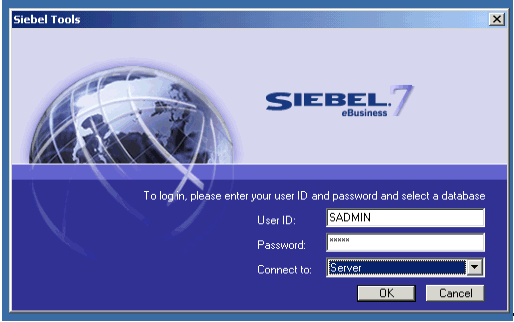
Perform the following steps:
Enter your user ID and password.
Select a database from the list.
Click OK.
The Siebel Tools window is displayed. Integration Objects appear in the right pane.

To create a schema, select an Integration Object, for example, Sample Account.
Click Generate Schema.
The Generate XML Schema wizard is displayed.

Perform the following steps:
From the Select a Business Service list, select EAI XML XDR Generator for XDR schemas or EAI XML XSD Generator for XSD schemas (for Siebel 7.5 and later).
From the Select an envelope type list, select Siebel Message envelope.
In the Choose the file name field, specify a file name for the XDR schema and a directory where it can be accessed by Application Explorer.
|
Note: The XDR schema file must be saved to a directory on the same computer as Application Explorer. |
Click Finish.
Now you can use Application Explorer to generate XML schemas for the Siebel Integration Object.
Creating a Schema from a Siebel XDR Schema
After you create the Siebel XDR schema for a selected Siebel Integration Object, you can create an XML schema using Application Explorer.
You must provide Application Explorer with the location of the previously created Siebel XDR schema for the particular integration object selected.
|
Note: The XDR file must be on the same computer as Application Explorer or be available through a mapped connection to another drive or machine. |
To create a schema from a Siebel XDR Schema:
In Application Explorer, expand the Integration Objects node to browse the Integration Objects in the Siebel system.

Scroll down and select an integration object, for example, Sample Account.
To generate event schema, right-click the object and choose Add event.
The Add Event dialog box is displayed. Perform the following steps:
Click Add.
The Schemas pane is displayed.

To view the XML for a schema, click the Event Schema tab.
The results appear in the right pane.

Click the browser Back button to return.
A directory structure is created to store the schemas.
You can now create an Integration Object node for Siebel. See "Creating Integration Object (IO) Nodes for Siebel" for more information.
To create an Integration Object node for Siebel, perform the following steps:
In Application Explorer, connect to a defined target. See "Connecting to a Defined Target" for information on how to connect to a target.
The X over the icon disappears, indicating that the target is connected.

Expand the Integration Object node and select Sample Account.
Right-click the Sample Account node and select Add IO Node.
The Add IO Node dialog box is displayed.
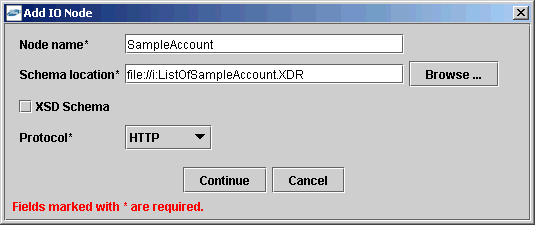
Please note:
For Siebel 7.5 or later: Generate XSD schemas directly from Siebel tools. You use the XSD schemas when you create Web services in Application Explorer. After you generate an XSD schema through Siebel tools, use it to create an IO node and a Web service.
For Siebel 7.0: You cannot generate XSD schemas directly from Siebel tools; only XDR schemas can be created. Before you create a Web service, you must first generate an XSD schema from the XDR schema using Application Explorer.
Enter a node name, for example SampleAccount in the Node name field and a path to the Sample Account XDR file in the Schema location field.
If the XSD schema has already been generated, select XSD Schema. If you are using Siebel-generated XDR schemas, do not select the XSD schema option.
Click Continue.
You can generate a business service (also known as a Web service) for Siebel objects you wish to use with your adapter after you have properly configured the servlet BSE.
|
Note: In a J2EE Connector Architecture (J2CA) implementation of adapters, Web services are not available. When the adapters are deployed to use OracleAS Adapter J2CA, the Common Client Interface provides integration services using the adapters. |
This section contains the following topics:
OracleAS Adapter for Siebel allows you to add a service node for a Business Service that includes methods containing method arguments having hierarchy data types.
Important limitations:
The adapter supports only Integration Object hierarchy data types.
Adding a Service node requires that you have previously generated an XSD schema for the Integration Object. For more information on generating XSD schemas for Siebel Integration Objects, see "Creating Schemas for Siebel Integration Objects".
Only one of the method arguments for the Business Service method for which you want to add a service node can be a hierarchical data type.
The method argument XMLCharEncoding is not supported. Leave this element blank in the XML payload. If you enter a valid XMLCharEncoding value such as UTF-8 or UTF-16, you will get the following error:
Invocation of Service failed.
To create the service:
Select the Business Service node in which you are interested.
Right-click the Business Service method argument for which you want to create a service and select Add Service Node.
The Add Service Node dialog box is displayed.

Perform the following steps:
Provide a service node name.
Enter a description (optional).
Provide the full path (including the file name) to the XSD schema file.
Specify the root element for the XSD schema file. For many XSD schemas for Integration Objects, the root element is SiebelMessage.
Specify whether the XSD schema is for an Integration Object.
Important: You must verify that this check box is selected.
Click OK.
The Service node is listed under the Business Service object.

You can right-click this node to create a Web service. The request and response schemas are displayed in the right pane.
The following procedure describes how to create a Web service for a Business Object.
To generate a Web service for a Siebel Business Object:
Connect to your Siebel system.
Expand a Business Object node.
Expand the Business Component for which you want to create a Web service.

Expand the object and select a method for creating the Web service, for example, QueryWithView under Account.
Right-click the node from which you want to create a business service and select Create Business Service.
The Create Web Service dialog box is displayed.
You can add the business object as a method for a new Web service or as a method for an existing one. Perform the following steps:
From the Existing Service Names list, select either <new service> or an existing service.
Specify a service name if you are creating a new service. This name identifies the Web service in the list of services under the Business Services node.
Enter a description for the service (optional).
Select one of the available licenses.
Click Next.
The License and Method dialog box is displayed. Perform the following steps:
In the License field, select one or more license codes to assign to the Web service. To select more than one, hold down the Ctrl key and click the licenses.
In the Method Name field, enter a descriptive name for the method.
In the Description field, enter a brief description of the method.
Click OK.
Application Explorer switches the view to the Business Services node, and the new Web service appears in the left pane.
After you create a Web service for the Siebel Business Object, test it to ensure it functions properly. Application Explorer includes a test tool for testing a Web service.
Testing a Web Service for a Business Object
In the left pane of Application Explorer, expand the Business Services node.
Select the name of the business service you want to test.

Expand the Methods node under the service and select the method you want to test.
The test option appears in the right pane.
If you are testing a Web service that requires XML input, an input field appears.
Click Invoke.
Application Explorer displays the results in the results pane.
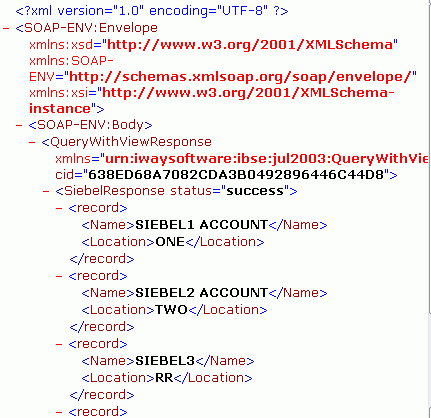
Testing a Web Service for a Business Service
After you create a Web service for the Siebel Business Service, test it to ensure it functions properly. Application Explorer includes a test tool for testing a Web service.
If it is not expanded, expand the Business Services node.
Expand the Services node.
Select the name of the business service you want to test.
Expand the Methods node and select the name of the method you want to test.
The test option appears in the right pane.
If you are testing a Web service that requires XML input, an input field appears.
Provide the appropriate input.
Click Invoke.
Application Explorer displays the results in the results pane.
Identity Propagation
If you test or execute a Web service using a third party XML editor, for example XMLSPY, the Username and Password values that you specify in the SOAP header must be valid and are used to connect to Siebel. The user name and password values that you provided for Siebel during target creation using Application Explorer are overwritten for this Web service request. The following is a sample SOAP header that is included in the WSDL file for a Web service:
<SOAP-ENV:Header>
<m:ibsinfo xmlns:m="urn:schemas-iwaysoftware-com:iwse">
<m:service>String</m:service>
<m:method>String</m:method>
<m:license>String</m:license>
<m:disposition>String</m:disposition>
<m:Username>String</m:Username>
<m:Password>String</m:Password>
<m:language>String</m:language>
</m:ibsinfo>
</SOAP-ENV:Header>
You can remove the <m:disposition> and <m:language> tags from the SOAP header, since they are not required.
The Web Service Definition Language (WSDL) description of a Web service enables you to make the service available to other services within a host server. You use Application Explorer to create both request-response (outbound) and event notification (inbound) JCA services of the adapter.
|
Note: The Create Inbound JCA Service (Event) option is only available when the selected node supports events. |
To generate a WSDL file for request-response service:
Under your connected Siebel target, expand Business Object, Account, Account. Navigate to an object and right-click the object.
The following menu is displayed.
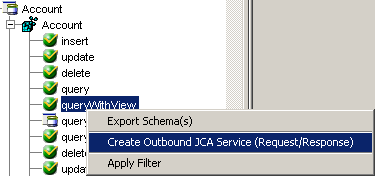
Select Create Outbound JCA Service (Request/Response).
The Export WSDL dialog box is displayed.

Accept the default name and location for the file.
The .wsdl file extension is added automatically. By default, the names of WSDL files generated for request-response services end with _invoke, while those generated for event notification end with _receive.
You can organize your WSDL files in subfolders, creating your own WSDL hierarchy structure. Create the folders under OracleAS_home\adapters\application\wsdls\. The WSIL browser in JDeveloper will display the full tree structure of your WSDL hierarchy.
Click OK.
The WSDL file is saved in the specified location.
The procedure for generating WSDL for event notification is similar to request-response. To generate WSDL for event notification, you must first create a channel for every event. See "Generating WSDL for Event Notification" for a detailed example.
Events are generated as a result of a specific business condition being satisfied or triggered in the Siebel system. You can use events to trigger an action in your application. For example, an update to a database can reflect an update to customer information. If your application must perform when this happens, your application is a consumer of this event.
After you create a connection to your application system, you can add events using Application Explorer. To configure an event, you must create a port and a channel.
|
Note: If you are using a J2CA configuration, you must create a new channel for every event and select this channel when you generate WSDL. Additionally, you are not required to create or configure ports for use with BPEL Process Manager. See "J2CA Filtering Port Option for Integration with BPEL Process Manager" for details on using ports under a J2CA configuration. |
A port associates a particular business object exposed by an adapter with a particular disposition. A disposition defines the protocol and location of the event data. The port defines the end point of the event consumption. See "Creating and Modifying an Event Port" for more information.
A channel represents configured connections to particular instances of back-end or other types of systems. A channel binds one or more event ports to a particular listener managed by an adapter. See "Creating and Modifying a Channel" for more information.
|
Note: OC4J currently conforms to J2CA 1.0, which does not call for event capabilities. When conforming to J2CA 1.0, only service interactions are supported. |
Please note that adding IO node functionality is not applicable in event configurations.
This section contains the following topics:
You can create an event port for a Siebel Integration Object from the Events node in Application Explorer. To create event ports for Siebel Business Objects and Siebel Business Services, you must use the Events node.
|
Note: You are not required to create event ports for J2CA configurations. You must create event ports for BSE configurations only. |
Creating an Event Port from the Adapters Node
For Siebel Integration Objects, you can bypass the Events node and create an event port directly from the Adapters node.
Select the IO node you created.
Right-click the IO node and select Add Port.
The Add Port dialog box is displayed. Perform the following steps:
Enter a name for the event port and provide a brief description.
From the list, select the required disposition, for example, RMI.
In the URL field, enter the disposition URL.
Click OK.
Create a DTD for a Siebel event in one of two ways:
Right-click the IO node under Integration Objects, and select Create Web Service. A DTD created this way will have the name of <Node_Name>_request.dtd.
Or
Right-click the IO node under Integration Objects, and select Create Event Port. A DTD created this way will have a name of <Node_Name>_event.dtd.
The following procedure describes how to create an event port from the Events node for an RMI disposition using Application Explorer.
To create an event port for Siebel Integration Objects, you must first indicate the location of the XDR schema for that object. See "Creating a Schema from a Siebel XDR Schema" for more information.
Creating an RMI Event Port from the Events Node
To create a specific event port for RMI:
Click the Events node.
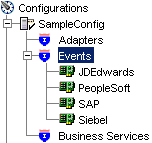
Expand the Siebel node.
Right-click the Ports node and select Add Port.
The Add Port dialog box is displayed. Perform the following steps:
Enter a name for the event port and provide a brief description.
From the Protocol list, select RMI.
In the URL field, specify a destination file to which the event data is written using the following format:
rmi://host:port;RemoteObject=APPNAME
Where APPNAME is the adapter name for the EIS Adapter Plugin you configured. The value for APPNAME must be in uppercase.
From the Disposition protocol list, select RMI.
The following table defines the parameters for the disposition.
| Parameter | Description |
|---|---|
| host | The host name or IP address from which the RMI server accepts RMI requests. If you omit this attribute, the RMI server will accept RMI requests from any host. |
| port | The port number on which the RMI server listens for RMI requests. |
| RemoteObject | A home or Enterprise JavaBeans (EJB) object. |
Click OK.
The port appears under the ports node in the left pane. In the right pane, a table appears that summarizes the information associated with the event port you created.
You are ready to associate the event port with a channel. See "Creating and Modifying a Channel" for more information.
Editing an Event Port
In the left pane, select the event port you want to edit.
Right-click the port and select Edit.
The Edit Port pane is displayed.
Make the required changes and click OK.
Deleting an Event Port
Select the event port you want to delete.
Right-click the port and select Delete.
A confirmation dialog box is displayed.
To delete the event port you selected, click OK.
The event port disappears from the list in the left pane.
J2CA Filtering Port Option for Integration with BPEL Process Manager
This feature provides the option to use event ports when using OracleAS Adapter for Siebel with BPEL PM under a J2CA configuration. Without this feature, all messages from a particular channel are forwarded to the endpoint and then to the BPEL PM Server. In this case, no schema validation takes place. With the filtering feature, you have the option to associate an event schema to a port that you create and configure in Application Explorer. In this case, at runtime the message is validated against the event schema and only the validated event message is forwarded to the endpoint. If the event message does not match the event schema that is associated to the port, then an error message is written to the log and the event message is ignored.
The following procedure describes how to create a channel for your event. All defined event ports must be associated with a channel.
|
Note: If you are using a J2CA configuration, you must create a new channel for every event and select this channel when you generate WSDL. Creating a channel is required for both BSE and J2CA configurations.If you are planning to integrate OracleAS Adapter for Siebel with BPEL Process Manager, do not start the channel, as it is managed by the BPEL PM Server. If you start the channel for testing and debugging purposes, stop it before runtime. |
Three channel types are available:
HTTP
MQ Series
File
|
Note: OC4J currently conforms to J2CA 1.0, which does not call for event capabilities. When conforming to J2CA 1.0, only service interactions are supported. |
The Events window is displayed. The adapters that appear in the left pane support events.
In the left pane, expand the Siebel node.
Right-click channels and select Add channel.
The Add Channel dialog box is displayed.

Perform the following steps:
Enter a name for the channel, for example, NewChannel.
Enter a brief description.
From the list, select HTTP Listener.
The following image shows the Select Ports dialog box.

Important: If you are using BPEL Process Manager with a J2CA configuration without the optional port feature, skip the following two steps. See "J2CA Filtering Port Option for Integration with BPEL Process Manager".
Select an event port from the list of current ports.
To transfer the port to the list of available ports, click the double right (>>) arrow. To associate all the event ports, control-click to select each port or click one port and press Control+A. Then, click the double right (>>) arrow.
Click Next.
When the dialog box is displayed, enter the system information as specified in the following table.
| Parameter | Description |
|---|---|
| Port | Port on which to listen for Siebel event data. |
| Server port | Port on which the host database is listening. |
| Synchronization Type | Synchronization types are not applicable to Siebel events. |
Click OK.
The summary pane is displayed.
A summary provides the channel description, channel status, and available ports. All the information is associated with the channel you created.The channel also appears under the channels node in the left pane

An X over the icon indicates that the channel is currently disconnected. You must start the channel to activate your event configuration.
Right-click the channel and select Start.
The channel you created becomes active. The X over the icon in the left pane disappears.
To stop the channel, right-click the channel and select Stop.
To create an MQ Series listener:
Click the Events node.
The Events window is displayed. The adapters that appear in the left pane support events.
In the left pane, expand the Siebel node.
The ports and channels nodes appear.
Right-click the channels node and select Add channel.
The Add a new channel pane is displayed. Perform the following steps:
Enter a name for the channel, for example, NewChannel.
Enter a brief description.
From the list, select MQ Series Listener.
The following image shows the Select Ports dialog box.

Important: If you are using BPEL Process Manager with a J2CA configuration without the optional port feature, skip the following two steps. See "J2CA Filtering Port Option for Integration with BPEL Process Manager".
Select an event port from the list of current ports.
To transfer the port to the list of available ports, click >>. To associate all the event ports, control-click to select each port or click one port and press Control+A. Then, click >>.
Click Next.
When the dialog box is displayed, enter the system information as follows.
In the Request tab, enter values for the following parameters:
| Parameter | Description |
|---|---|
| Queue manager name | The host on which the MQ Server is located (MQ Client only). |
| MQ server host for MQClient operation | Port on which the host database is listening. |
| MQ server port for MQClient operation | The number to connect to an MQ Server queue manager (MQ client only).
REQUEST REQUEST_RESPONSE REQUEST_ACK |
| MQ server channel for MQClient operation | The case-sensitive name of the channel that connects with the remote MQ Server queue manager (MQ client only). The default channel name for MQSeries is SYSTEM.DEF.SVRCONN. |
| Document type XML | Leave the default selection. |
| Request queue name | Queue where the message is routed and where request documents are received. The name of the queue is case-sensitive and conforms to the following format:
Host\queue type$\qName Host Is the machine name where the MQ Series queuing system is running. queue type Private queues are queues that are not published in Active Directory and appear only on the local computer where they reside. Private queues are accessible only by Message Queuing applications that recognize the full path name or format name of the queue. qName Is the name of the queue where messages are placed, for example, iwaykxc1\Private$\siebel |
In the Response tab, enter values for the following parameters:
In the Advanced tab, enter values for the following parameters.
| Parameter | Definition |
|---|---|
| Error Directory | Directory to which documents with errors are written. |
| Message wait interval (msec) | The interval (in milliseconds) when to check for new input. The default is 3 seconds. Optional. |
| Mode of operation | Choose Sequential or Threaded.
|
| Thread limit | If you selected threaded processing, indicate the maximum number of requests that can be processed simultaneously. |
Click OK.
The summary pane is displayed.
A summary provides the channel description, channel status, and available ports. All the information is associated with the channel you created. The channel also appears under the channels node in the left pane
An X over the icon indicates that the channel is currently disconnected. You must start the channel to activate your event configuration.
Right-click the channel and select Start.
The channel you created becomes active. The X over the icon in the left pane disappears.
To stop the channel, right-click the channel and select Stop.
The Events window is displayed. The adapters that appear in the left pane support events.
In the left pane, expand the Siebel node.
The ports and channels nodes appear.
Right-click the channels node and select Add Channel.
The Add Channel dialog box is displayed. Perform the following steps:
Enter a name for the channel, for example, NewChannel.
Enter a brief description.
From the list, select File Listener.
The following image shows the Select Ports dialog box.

Important: If you are using BPEL Process Manager with a J2CA configuration without the optional port feature, skip the following two steps. See "J2CA Filtering Port Option for Integration with BPEL Process Manager".
Select an event port from the list of current ports.
To transfer the port to the list of available ports, click the double right (>>) arrow. To associate all the event ports, control-click to select each port or click one port and press Control+A. Then, click the double right (>>) arrow.
Click Next.
When the dialog box is displayed, enter the system information as follows.
In the Request tab, enter values for the following parameters:
| Parameter | Description |
|---|---|
| Polling Location | The target file system location for the Siebel XML file. |
| File Mask | The file name to be used for the output file generated as a result of this operation. |
In the Response tab, enter values for the following parameters:
| Parameter | Definition |
|---|---|
| Synchronization Type | Synchronization types are not applicable to Siebel events. |
| Response/Ack Directory | Directory where responses or acknowledgments are sent. |
In the Advanced tab, enter values for the following parameters:
| Parameter | Definition |
|---|---|
| Error Directory | Directory to which documents with errors are written. |
| Poll interval (msec) | The interval (in milliseconds) when to check for new input. The default is 3 seconds. Optional. |
| Processing Mode | Choose Sequential or Threaded.
|
| Thread limit | If you selected threaded processing, indicate the maximum number of requests that can be processed simultaneously. |
Click OK.
The summary pane is displayed. A summary provides the channel description, channel status, and available ports. All the information is associated with the channel you created. The channel also appears under the channels node in the left pane.
An X over the icon indicates that the channel is currently disconnected. You must start the channel to activate your event configuration.
Right-click the channel and select Start.
The channel you created becomes active.
The X over the icon in the left pane disappears.
To stop the channel, right-click the channel and select Stop.